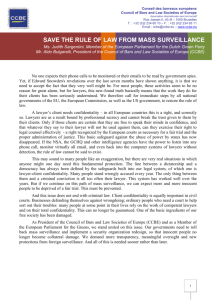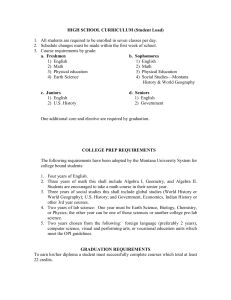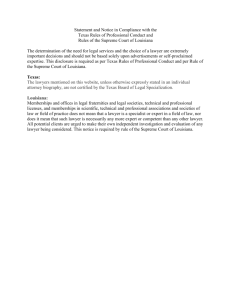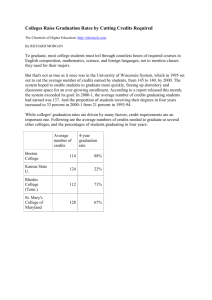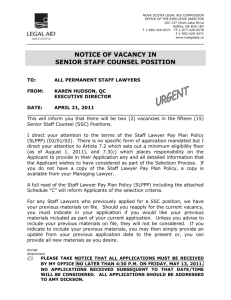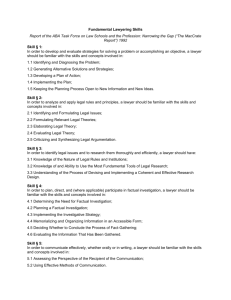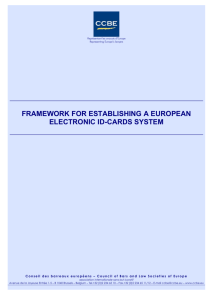Continuing Professional Training
advertisement
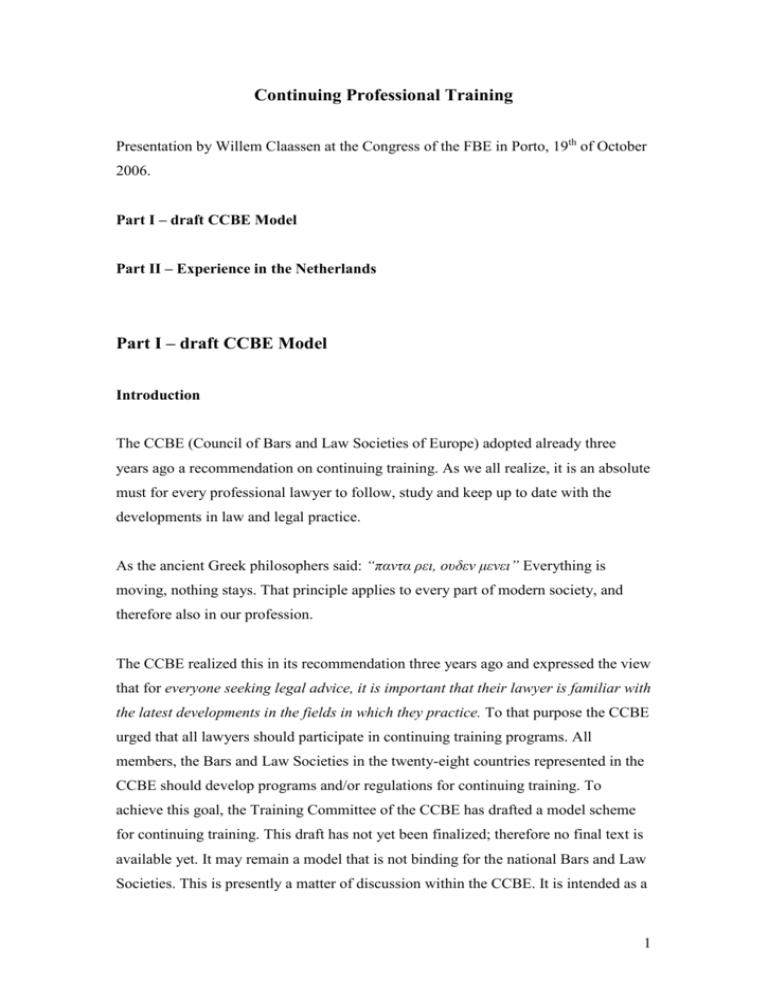
Continuing Professional Training Presentation by Willem Claassen at the Congress of the FBE in Porto, 19th of October 2006. Part I – draft CCBE Model Part II – Experience in the Netherlands Part I – draft CCBE Model Introduction The CCBE (Council of Bars and Law Societies of Europe) adopted already three years ago a recommendation on continuing training. As we all realize, it is an absolute must for every professional lawyer to follow, study and keep up to date with the developments in law and legal practice. As the ancient Greek philosophers said: “παντα ρει, ουδεν μενει” Everything is moving, nothing stays. That principle applies to every part of modern society, and therefore also in our profession. The CCBE realized this in its recommendation three years ago and expressed the view that for everyone seeking legal advice, it is important that their lawyer is familiar with the latest developments in the fields in which they practice. To that purpose the CCBE urged that all lawyers should participate in continuing training programs. All members, the Bars and Law Societies in the twenty-eight countries represented in the CCBE should develop programs and/or regulations for continuing training. To achieve this goal, the Training Committee of the CCBE has drafted a model scheme for continuing training. This draft has not yet been finalized; therefore no final text is available yet. It may remain a model that is not binding for the national Bars and Law Societies. This is presently a matter of discussion within the CCBE. It is intended as a 1 framework for the development of guidelines or regulations in the home jurisdictions of the CCBE members. The latest version of the draft model was formulated in September 2006 and consists of six articles. The main contents are as follows. Article 1 Article 1 deals with definitions of the lawyer, the Bar or Law Society and more important: what is to considered as a Training Institution? This is defined as an Institution where courses are given by persons skilled in the provision of professional training: for example Public Universities but also private schools and training centres. Important is that also law firms themselves can be qualified as training institutions, if they provide in-house courses for professional training. Furthermore art. 1 defines the crucial concept of so-called training credits. Like in any school of learning, there must be a method to measure the studies, either in quantum or in quality, or both. The model has opted for a quantitative approach. Every hour spent in training may result in a number of credit points. For example: one hour of attending training courses may equal one credit point. It is left to the national Bar or Law Society to determine this relationship. Credit points may also be earned by giving training courses as a teacher or lecturer. Moreover writing a legal article that is published may also count for earning credit points. Finally other training than strictly legal may count, such as for example training relating to management skills or peer review. Again the question of how many credit points is left open for the member associations. And likewise the precise quality requirements for a legal article, the length or hours spent writing it. Article 2 Article 2 stipulates that the model applies to all lawyers, who have been admitted to the Bar and provided they have completed their traineeship. This is again something to be worked out by the national Bars, and also whether an exception may be made to non-practicing lawyers. 2 Article 3 Article 3 deals with the most important part, namely the minimum amount of training points to be earned per year. By way of example, the model requires sixteen training credits per year. This requirement is implemented differently in various national jurisdictions. For example: in Belgium the French bar requires twenty hours over a period of three years, the Flemish Bar sixteen hours. England and Wales sixteen hours per year, the Netherlands sixteen points, Finland three days, France eighteen hours. The obligation of a certain number of points per year shall be reduced proportionally, if the lawyer has worked less than eleven months. Moreover the training points to be earned may be subject to the condition of specific legal training, such as on EU Law and professional ethics or deontology. Or subject to a certain maximum of non-legal training programs. It may well happen, that a lawyer has spent more time in training than the minimum of say sixteen hours per year. In one year he may follow very intensive, time consuming training programs. As a result he may have earned more training points than the required minimum. In such a case the model provides the possibility of carrying forward the extra points earned to the following year. Again it is a matter for the national Associations to regulate this in more detail such as how many training points may be carried forward and for how many successive years. Article 4 Article 4 provides for exemption from the continuing training obligation under specific circumstances. For example in case of long-term disability because of sickness or compliance with other training obligations. Article 5 Article 5 provides for bookkeeping. Every lawyer must record the number of training points he has earned and submit these together with documentary proof to the Bar or 3 Law Society for inspection. Every national association will have to organize a method of checking the training points earned. Article 6 The final article 6 provides for sanctions if a lawyer does not fulfil to the obligation to earn a minimum amount of training points per year. The disciplinary aspects will of course be dependent on the national codes of conduct or the general disciplinary rules. No text is yet available for this article. Part II – Experience in the Netherlands The CCBE Model is very much based on the Dutch regulation on Continuing Education. Therefore there is a good reason to explain to you the Dutch regulation which was adopted in 1994 and which is now working for over ten years. The relevant rules can be found on the website of the Netherlands Bar Association and are also available in English, see www.advocatenorde.nl. Training credit points The training credit is expressed in points, which are earned as follows. a. Taking a training course for sixty minutes, which benefits professional practice or the operation of a practice, with a recognized training institute, leading to a certificate issued by that instituted stating that the training course has been taken or completed or that the candidate has passed the test or exam relating to the training course. b. Teaching thirty minutes subject to the same conditions, c. Writing five hundred words of an article on a legal subject, which has been published in a legal journal or equivalent publication. 4 For whom? The regulation is binding on any lawyer after he has completed the period of traineeship, which lasts as a rule three years. During his traineeship the lawyer is obliged to follow a special and separate training for junior lawyers. How many credits? The lawyer must earn 16 credits every year. To earn these credits, he may follow 16 hours of classes or give lectures during 8 hours or write an article of 16 x 500 words. He can choose between these three possibilities. At least half of the credits earned must relate to legal subjects; the other half may consist of non-legal training activities, provided these benefit professional practice. Any credit points in excess of 16 per year may be used to reduce the number of credits to be earned in the next two years. The carry over is therefore limited to two successive years after the year the excess has been earned. If the credit surplus is not used up in the next two years, they shall become worthless. In case there is a credit shortage, this cannot be compensated from the following year's surplus. Training Institute The recognition of a training institute is a matter to be decided by the General Council of the Netherlands Bar Association. The General Council has formulated the conditions in a separate regulation. A law firm may qualify also for recognition if it satisfies these conditions. These include the following: Education for the benefit of the legal practice Competent teachers Evaluation of the education by forms to be filled in Attendance certificates The recognition can be given subject to further specific conditions. In practice many law firms have obtained such recognition for in-house training programmes. These are usually given in combination with lunch breaks or after office hours, either by lawyers 5 of the firm or external teachers. Law firms may also set up half weekends for training of their lawyers, hiring a hotel or conference centre and spending the Friday afternoon in training conferences, the Friday evening for social activities and the Saturday morning again for training programmes, which may add up to 6 training credits. A recognised training institute, not being a law firm, may use an official logo from the Netherlands Bar Association and must publish for each course that it offers the number of credit points to be earned. In a special Decree training abroad has also been accepted as equivalent to training programmes in the Netherlands. The conditions for the recognition of training abroad, either taking or teaching a training course, are as follows: The training course must be beneficial to the professional practice The training course is offered by o a university o an institute that cooperates with a university o an institute that employs university lecturers or other expert teachers o an institute recognised as such by the National Bar Association of that country Exemption The General Council may grant a lawyer partial or total exemption from the obligation of 16 training credits per year. In practice this has not proved to be very easy. There are two categories where the General Council has granted exemption, namely a. in case of pregnancy for 4 months reducing the annual amount with 5 credit points, b. in case of a lawyer practising abroad with a reduction of 6 training points, such for a period of maximum 3 years. 6 Otherwise, exemption from the 16 training credits obligation will be very difficult. In the past exemption was not granted in the following situations: cancellation of a course by the training institute, as a result of which the lawyer was unable to earn the mandatory number of training credits falling one credit short of the mandatory amount being 50% unfit for work and therefore only practising law parttime the advanced age of a lawyer practising law in a special field having only a limited scope of practice intending to cease practising law in the near future preparing a publication for a legal journal or a law book sidelines, such as membership of the House of Parliament The rule is therefore observed very strictly. Records Every lawyer shall be obliged to provide the Dean or the central secretariat of the Netherlands Bar the information about compliance with the regulation, in other words the bookkeeping of the training credits. Every lawyer receives to that purpose a file from the central secretariat, in which he can record per year the training credits earned, specifying the respective training institute and certificate of attendance. Also it shows the excess credits earned in a given year and the carry over to the following two successive years. Every lawyer has to send in his record within three months after each calendar year. The secretariat is entitled to check these records and as a rule will do so if the records are not submitted in time. Sanction The regulation does not provide for sanctions. This is not necessary, as violation of the regulation is an offence of the disciplinary rules laid down in the Act on Lawyers, article 46 of the so-called "Advocatenwet". Such offence will be prosecuted with a complaint by the Dean with the Disciplinary Council. This may lead to a judgment 7 against the lawyer and disciplinary sanctions, which may vary from a simple warning to in the worst case deleting him from the registry of lawyers, therefore disbarring him. In practice, it does happen once in a while that a lawyer is subjected to disciplinary measures because of violating the regulation on continuing education. Out of the approximately 14 thousand lawyers in the Netherlands it is my estimate that less than 10% is violating this regulation and out of this number only a limited amount of less than 1% leads to disciplinary sanctions. Still, it is too many and at any event it is usually a very good - if not embarrassing - lesson for the lawyer concerned and for the benefit of a continuing professional training. 8
